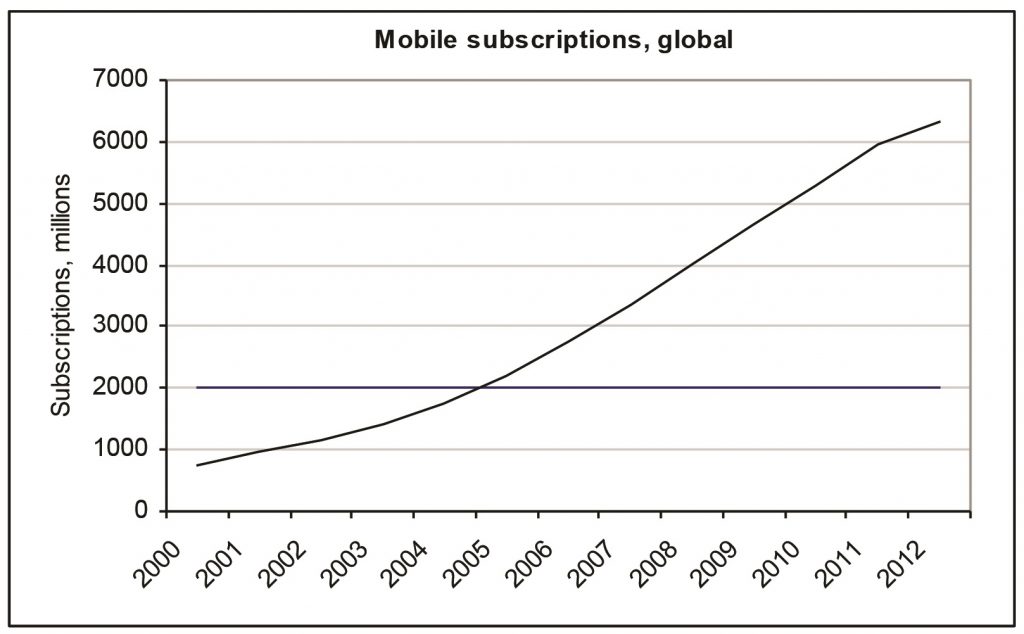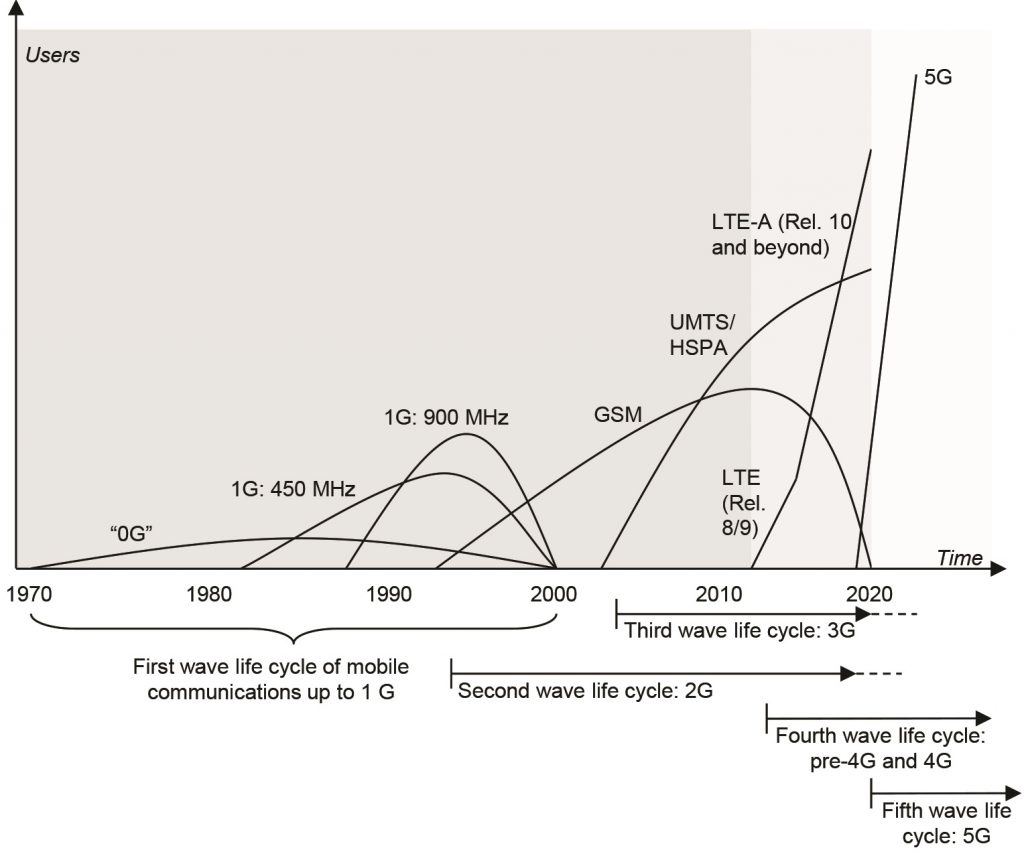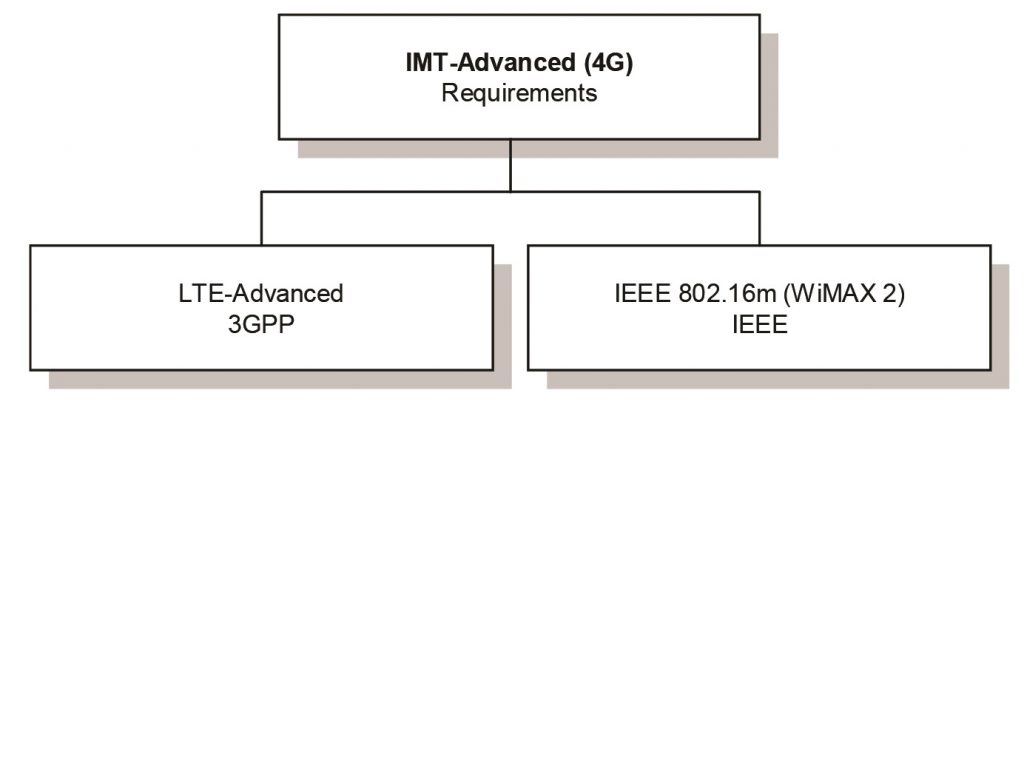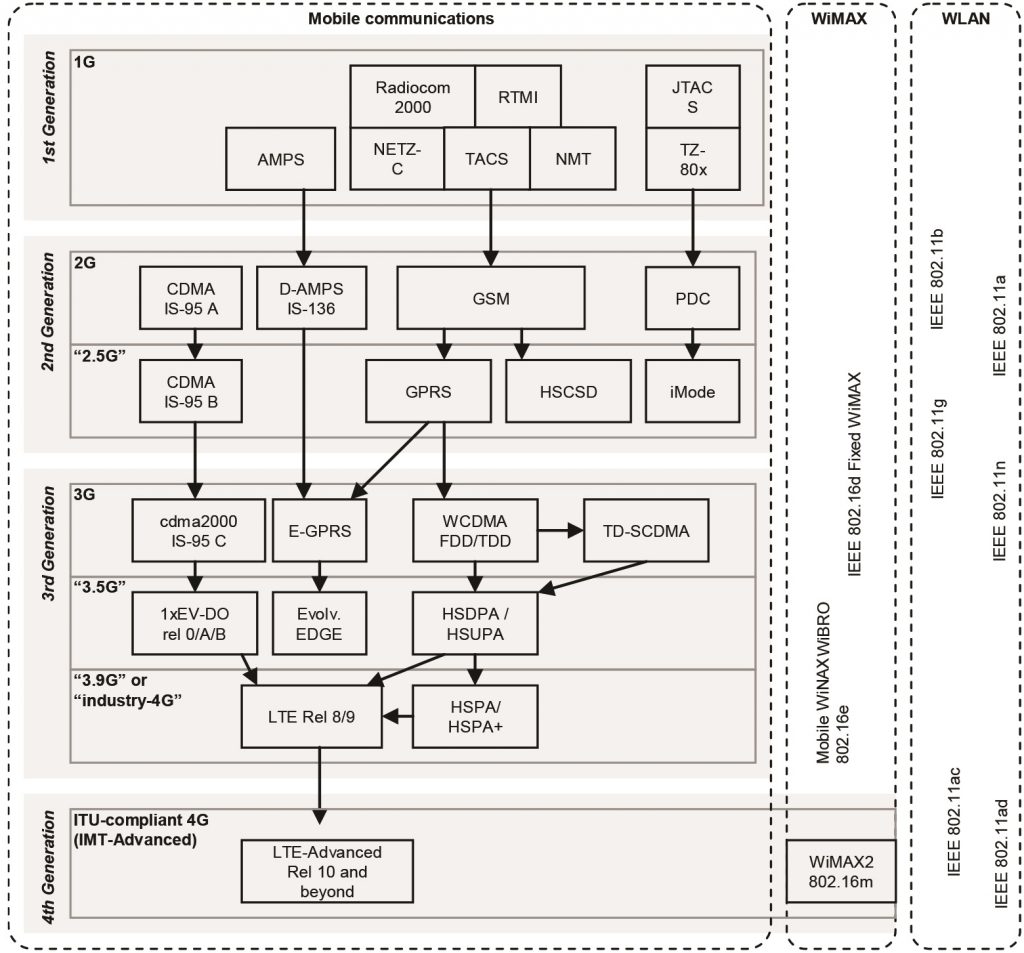The evolving mobile communications technologies provide us with vastly increasing data rates, faster response times and increasingly fluent means to access more content than ever in the history of telecommunications. Along with the development of the standards, the commercial solutions keep appearing for our selection. Often in this highly dynamic environment, the vast amount of technical and marketing terms gives us challenges in capturing the real meaning of the messages that operators, device vendors and service providers want to give us. One of the most confusing topics in this field is the definition of the “mobile communications generations”, so let’s solve the mystery.
INTRODUCTION
GENERATION ZERO SHOWED POTENTIAL
Early mobile networks paved the way to a totally new era liberating users from communicating in fixed locations back in late 80s. In fact, there were some much earlier systems deployed although
they have been basically forgotten in the history. As an example, Swedish automatic MTA (Mobile Telephony System version A) was deployed already in 1956 for operative use in Stockholm and Gothenburg. As the equipment was bulky, it was suitable merely for car mounted environment. This initiation was still ahead of time, so it did not have commercial success. As another example from 1971, the technology was finally mature enough in Finland for the commercial launch of ARP (Auto Radio Phone), which functioned in 160 MHz band until 2000 – serving customers especially in remote areas whole 3 decades. Parallel systems were adopted also in many locations in 450 MHz band. All these initiations may be referred to as “Generation 0” with relatively small user base and still portability limitations.
ANALOGUE ERA KICKED OFF MOBILE COMMUNICATIONS
The evolution started to really take off during 1980s along with the first generation mobile communications networks that had fully automatic functionalities for establishing voice calls.
Some examples of the 1G networks were AMPS (Advanced Mobile Phone System) in Americas and TACS (Total AccessCommunications System) in the UK. There also were a diversity of similar kind of networks in other locations of the globe, of which the slightly more international variant was NMT 450 (Nordic Mobile Telephony) and its enhanced version NMT 900 in Nordic countries.
Now obsolete, the 1G cellular networks showed concretely the benefits of location and time independent communications which has resulted in dominating position of mobile users compared to land line subscriptions already for years ago. Looking back at history, the growing popularity of the voice service – thanks especially to the 1G systems – came often as a complete surprise to operators and regulators in late 80s and early 90s which caused challenges in keeping up with the capacity demand. The more accessible prices of the devices and their utilization triggered the sudden interest which in turn made mobile business growing faster than any estimation was capable of indicating at that time whatsoever. The mobile user base stillkeeps increasing, and thanks to the raising popularity of multiple subscriptions per customer, we are still far away from the saturation levels as can be seen from ITU (International Telecommunications Union) statistics (Figure 1). Furthermore, the growing business for Internet of Things will contribute to the total growth figures as the automatized communications between machines requires ever increasing number of subscriptions.
DIGITAL ERA EXPLODES THE BANK
The offered capacity of the 1G systems was rather limited, and regardless of some international functionality especially via NMT, the roaming concept was still fairly new and limited. These
were some of the reasons for the further development of fully digitalized, second generation mobile communication systems like CDMA-based IS-95 in Americas. As for the number of users,
GSM (Global System for Mobile Communications) has been the most popular 2G variant up to date. GSM also introduced the separation of the terminal and subscriber data storage (SIM, Subscriber Identity Module) for easier changing of the device yet maintaining the mobile telephone number. The 2G systems started to include growing set of enhanced services, from which the Short Message Service (SMS) is an example of the most successful mobile communications solutions of all times.
The digital 2G systems contained already in-build capabilities for data transmission, and after the further specification efforts, the mobile data services started to take off in the beginning of
2000 along with the packet switched data transmission. This can be interpreted as the starting point for the development of mobile communications towards the all-IP environment. As an example of today, GSM is able to offer data speeds of over 500 kb/s which is pretty amazing achievement for a 2G system
comparing it to the original 9.6 kb/s back in 90s.
3G INITIATES THE MOBILE MULTIMEDIA
Regardless of the highly advanced and novelty solutions 2G networks have offered, their limits were understood in relatively early phase which triggered the standardization of even more
advanced 3G systems. As a result, American cdma2000 and European UMTS (Universal Mobile Telecommunications System) were ready to be deployed in early 2000. One of the main benefits
of 3G is the considerably higher data rates, e.g., via 1x-EV-DV of cdma2000 and HSPA (High Speed Packet Access) of UMTS. The basic guideline for 3G systems comes from ITU (International
Telecommunications Union) which has accepted a set of commercial 3G systems under the IMT-2000 (International Mobile Telecommunications) umbrella. UMTS (with few variants) and cdma2000 comply with these requirements together with EDGE, DECT and WiMAX.
Ever since, higher data rates have been desired and offered. The main driver for the 3G systems was in fact the need of higher data rates as base for the fluent consumption of increasingly advanced multimedia services. Since the early days of 3G networks, the mobile data services have developed drastically from the original, some hundreds of kb/s speeds up to current tens of Mb/s category.
DEVELOPED 3G ERA ENSURES HIGH-SPEED DATA
FOR ALL
Even if it is technically doable to enhance further the older technologies like CDMA and GSM, there is a limit as for the techno-economic feasibility, which justifies the introduction of
modernized technologies within the 3G path. The basic reason for this is the better spectral efficiency the post-2G systems which is a result of the advances in the overall telecommunications
technologies, processor performance and due to better understanding of the theories in the constant efforts to reach the performance limits. This is thus a logical moment for continuing
the deployment of enhanced 3G systems of which LTE (Long Term Evolution) is the most popular representative that started to be available by first operators as of 2010-11. It is capable of offering
better spectral efficiency than any of the previous systems have been able to do and moves the data service reference to new decade by providing hundreds of Mb/s data rates. WiMAX is
another representative in the advanced 3G path, although its wider commercial use is yet to be seen.
4G CONFUSES AND ENHANCES
Up to 3G era, the terminology for distinguishing between the mobile system generations has been mostly understandable and the commonly agreed definition of 3G, based on ITU’s IMT-2000
requirement umbrella, is logically aligned with the previous 2G and 1G networks. Nevertheless, the term “4G” seems to be somewhat confusing. There are several interpretations, the strictest
one coming from the ITU that accepts only the evolved versions of LTE and WiMAX to the 4G category. Logically thinking, the basic version of LTE that is defined in the 3GPP Release 8 specifications is relatively close to 4G and could thus be considered as a “beyond 3G, pre-4G” system, also sometimes referred to as 3.9G technology in a non-standard communications. In practice,
many operators and device manufacturers are interpreting LTE to belong to fourth generation as such.
Investigating the history behind the definition of 4G, ITU’s Radiocommunication Sector ITU-R completed the assessment of six candidate submissions for the global 4G mobile wireless broadband technology by 21 October 2010. According to the ITU-R terminology, the fourth generation refers to IMTAdvanced that contains various technical requirements, e.g., for
the data rates. The proposals resulted in two 4G technologies, “LTE-Advanced” and “WirelessMAN-Advanced”, i.e., IEEE 802.16m which also is commonly known as “WiMAX 2”. Only these solutions have been recognized officially by ITU-R as 4G technologies by now, although the practical interpretation of the mobile telecommunications industry is somewhat more liberal (Figure 3).
Looking at the IMT-Advanced documentation, it is clear that the initial version of LTE is not capable for meeting with the expected 4G performance values. As an example, LTE prior
to the Release 10 is not able to provide the 1 Gb/s data rate in downlink which is one of the requirements of IMT-Advanced. Yet, it is common to see the early version of LTE and sometimes
even UMTS HSPA+ networks being called as 4G.
WHERE IS 5G?
Interestingly, as the utilization of term “4G” has been used actively in the commercial pre-LTE-A Rel. 10 era, there seems to be some kind of inflation noted in the terminology as some systems
might be called already as “5G”. Nevertheless, the ITU-compliant 5G is still only a concept that is currently under brainstorming, and the potential 5G deployment could take place around 2020
time frame. We thus need to wait still for a while to be able to experience the forthcoming performance of the real 5G.
CONCLUSION
The mobile telecommunications industry has typically interpreted that the basic LTE may already be called as 4G. The practical explanation of these statement could be that LTE, in
fact, is much closer to 4G than to 3G, and thus the 4G as a term has already been adopted in the marketing of LTE. Another reason is also the relatively long time the standardization takes, and the industry has obviously wanted to distinguish already between the older 3G era with the introduction of LTE. Thirdly, markets have simply decided that the final word for the practical definition of term “4G” is not written on stone so it is only fair to have some level of freedom for interpretation.
Regardless of the classification of LTE as a last step of 3G, or as a first or pre-step in 4G era, it paves the way to the actual ITUR–defined 4G, and latest by the deployment of LTE-Advanced
providing the gigabit experiences, the networks can be claimed to represent full-bloodied 4G system. Depending on the final role and success of WiMAX, this might be actually the first time in mobile communications history for the real merging of the solutions into a single solution, based on the LTE.
It is good to remember that the 4G experience is a sum of many items like evolved antenna technologies, carrier aggregation and new mobile device categories so the highest data rates
will be available for us consumers in a gradual manner. It also is important to note that the latest 4G performance requires the support of these functionalities from both network and user
equipment. Meanwhile, it is after all not so big deal what performance is behind the term 4G whilst the user experience proofs clear difference between the older solutions and the new ones.
So folks, let’s enjoy the most advanced mobile communications without worrying too much about the terminology!
ABBREVIATIONS
AMPS Advanced Mobile Phone System, 1G network
in North America and Australia
cdma2000 American 3G network
D-AMPS Digital AMPS, 2G network
EDGE Enhanced Data Rates for Global Evolution,
evolved GPRS
E-GPRS Enhanced GPRS
GPRS General Packet Radio Service of GSM
GSM Global System for Mobile communications,
2G network
HSPA High Speed Packet Access, evolved 3G data service
of UMTS
IS-95 CDMA-based network, 2G network
JTACS Japan Total Access Communications System,
1G network
LTE Long Term Evolution, pre-4G system
LTE-Advanced 4G system defined by 3GPP
Netz-C 1G network in Germany, Portugal and South Africa
NMT Nordic Mobile Telephone, 1G system in Nordic
countries, Netherlands, Switzerland, Eastern Europe
and Russia
Radiocom 2000 1G network in France
RTMI Radio Telefono Mobile Integrato, 1G network in Italy
TACS Total Access Communications System, 1G network
in the UK
TZ-801/ 802/803 Japanese 1G networks of NTT
UMTS Universal Mobile Telecommunications System,
3G network
W-CDMA Wideband CDMA (belonging to UMTS)
SOURCES
The LTE/SAE Deployment Handbook, Wiley, 2011.
The Telecommunications Handbook: Engineering Guidelines for Fixed, Mobile
and Satellite Systems, Wiley, 2015
ABOUT THE AUTHOR
The author of this article, Dr. Jyrki Penttinen has insights to
the telecom world as a result of professional experiences from
all the mobile system generations. He has worked with mobile
network operators and OEMs in technical management and
expert positions in the USA, Finland, Spain and Mexico, and
as independent consultant in Europe and Latin America. His
technical interest areas include GSM, UMTS, LTE and mobileTV,
and he has performed related activities in radio and core
network planning, optimization, standardization and research.
Currently, he works in mobile security domain in New Jersey
with Giesecke & Devrient America, Inc. He also is active lecturer
and contributor to technical publications, the most recent ones
being The Telecommunications Handbook (Wiley 2015) and The
LTE/SAE Deployment Handbook (Wiley 2011) of which more
information can be found from www.tlt.fi. In his free time, he
enjoys communicating via Morse code at his ham radio stations.
Summary of the Generations
| Generation
|
Definition
|
| 1G | Analogue, first completely or almost completely automatic mobile networks that were meant for only voice calls, although accessory-based solutions were possible to adapt for data usage. The initial systems were based on vehicle mounted user equipment which could also be used as portable devices. The weight was typically several kilograms, and there was a separate auricular. Some examples of this phase of 1G are NMT-450, Netz-C, AMPS. In the further development of 1G, there were also hand-held devices introduced although the first ones were large and heavy compared to modern devices – those were definitely not meant for pockets. Example of this phase is NMT-900 that was launched in Nordic countries 1986-87.
|
| 2G | The most important differentiator of 2G was the digital functionality which provided integration of also data services into the system and devices. Examples of this generation are GSM and IS-95.
|
| 3G | The further development of multimedia-capable systems led into the third generation. The main differentiator of this generation is the possibility to use considerably higher data rates. According to the original set of ITU’s performance requirements, LTE belongs still to the 3G phase.
|
| 4G | ITU-R has defined a set of principles and performance requirements for the fourth generation systems. In the initial phase of the compliance review by ITU, there were 2 systems that complied with the requirements, i.e., the advanced version of LTE (LTE-A, as of Release 10) and WiMax (as of WirelessMAN-Advanced). As the mobile telecommunications markets have been growing heavily, and the competition is tougher than ever, there have been also parallel interpretations of the 4G capabilities. Often, the Release 8 LTE is interpreted to belong to 4G, and also HSPA+ is considered by various operators to be a 4G system.
|
| 5G | Ideas beyond IMT-Advanced to provide much higher data rates, with focus on the expected deployment in 2020. |
Figure 1 – Global evolution of the mobile subscriptions (ITU
statistics).

Figure 2 – The trends of the mobile evolution paths,
including LTE-Advanced. The 1G systems are already
obsolete. GSM has dominated the 2G era and it still functions as a
useful base especially for voice communications and for re-farming
the services to more spectral efficient 3G and 4G systems.

Figure 3 – The 4G systems approved by ITU-R.

Figure 4 – Some commercial mobile systems of 1G,
2G, 3G and 4G. The 4G era converges the mobile and
wireless LAN.





